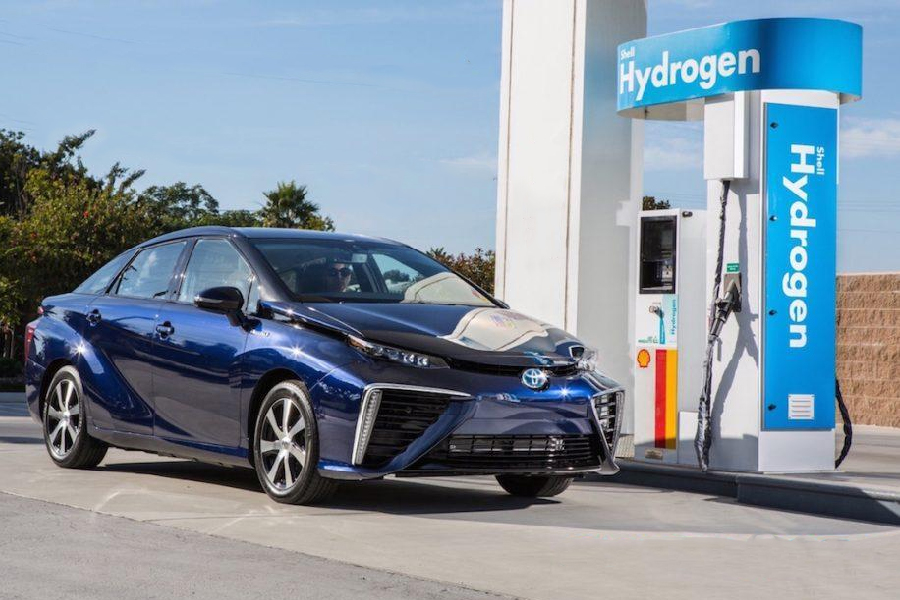Hydrogen economy for a healthier environment
With appropriate capacity addition to renewable power generation and a favourable policy ecosystem, India can catapult itself as a South Asian leader in producing affordable green hydrogen. It can even potentially emerge as a leading exporter of hydrogen like Australia, Netherlands, Canada and USA.
- Hydrogen (particularly ‘green hydrogen’ produced from renewable electricity or ‘blue hydrogen’ obtained from fossil fuels with carbon capture and storage) could be India’s hope for decarbonizing development.
- Hydrogen is a convenient and secondary fuel source with a versatile set of industrial applications which can significantly help India, the planet’s third-largest emitter of carbon dioxide, to decarbonize its growth.
- However, one of the key disadvantages of using green and blue hydrogen is the high cost of producing and maintaining it.
- Yet, its important to recognize that developing economies have at least as much to gain from a move towards green hydrogen as industrialized ones.

Source: Shutterstock
There’s a universal clamor to decarbonize development in order to cut down greenhouse emissions and check global warming. With the debate intensifying around net zero carbon emissions, the pressure on India, particularly, is mounting as it is seen as the planet’s third-largest emitter of carbon dioxide. Hydrogen (particularly ‘green hydrogen’ produced from renewable electricity or ‘blue hydrogen’ obtained from fossil fuels with carbon capture and storage) could be key to India’s vision for decarbonizing development. A TERI report estimates that the potential scale of hydrogen use in India is likely to increase between 3 and 10 times by 2050. It goes on to state:
Given the limits of direct electrification and the potential of hydrogen to overcome some of these barriers, we see it as the next clean energy prize under the energy transition. A range of countries, companies and multi-lateral organisations are already pushing ahead with ambitious plans to develop and deploy hydrogen at scale.
Is it as light as it gets?
Hydrogen, the lightest element on earth, is estimated to account for 90% of all atoms in the universe, and it is essential to the material world. Another advantage of hydrogen is that it can be obtained from a number of sources.
‘Grey hydrogen’ is produced from fossil fuels (& is therefore, relatively less eco-friendly), ‘blue hydrogen’ can be manufactured from fossil fuels with carbon capture and storage and ‘green hydrogen’ is made from renewable electricity (& is hence, the most eco-friendly fuel). Hydrogen, especially the blue/green one, can play an integral role in curtailing the country’s carbon dioxide emissions and improving air quality. Consequently, as people breathe fresh air, diseases related to air pollution like allergic cough are also likely to drop.
Another major advantage of hydrogen is its versatile uses. For example, liquid hydrogen (LH2) fuel has played an important role in space exploration since NASA’s Apollo program and can be used in fuel cells to produce electricity. Apart from this, it can be used to make steel, aluminium, electronics and in public transportation. Plus, unlike some of the other forms of energy like solar power, it can be obtained any time. Prof. Rangan Banerjee, Forbes Marshall Chair Professor and Head of the Department of Energy Science and Engineering, IIT Bombay, explains:
Hydrogen is a convenient and secondary fuel source. Let us take the example of obtaining hydrogen from solar PVs. All the generation which will happen will be during the sunshine hours, and the excess energy produced will have to be stored. It is costly to store that energy. The advantage of hydrogen is that we can produce it anytime, store it and use it.
Given its advantages, many countries in the world are making a transition to hydrogen. For example, in June 2018, then-Minister for Ecological and Inclusive Transition Nicolas Hulot vowed to establish France as world leader in hydrogen. Few months down the line, the country deployed its first hydrogen-powered passenger bus.
Germany has adopted a €9 billion (US$ 10.2 billion) National Hydrogen Strategy, with emphasis “green hydrogen” production. It is one of the first countries in the world to do so. Japan has set an ambitious target of setting up 40,000 fuel cell vehicles by 2020; 200,000 fuel cell vehicles by 2025; and 800,000 by 2030; 320 hydrogen refuelling stations by 2025; and 900 by 2030; and. 1,200 fuel cell buses by 2030. South Korea also rolled out the Economic Promotion and Safety Control of Hydrogen Act, which deals with three key areas – hydrogen vehicles, charging stations and fuel cells.
India too has taken a few steps in this regard. Lately an alliance of energy and industrial firms named India H2 Alliance (IH2A) has come together for commercializing hydrogen technologies and creating a hydrogen economy. It will focus on the establishment of standards for storage and transport hydrogen in pressurized and liquefied form. Further, Fusion Fuel Green — which has offices in Ireland and Portugal —signed an agreement with BGR Energy Systems to collaborate in this field.
Meanwhile, the Government of India is working well on its plan to boost India’s renewable power capacity to 175 gigawatts (GW) by 2022. It has also given impetus to scaling up the gas pipeline infrastructure across the country and is working to scale up its power grid system. Further, the Finance Minister in the Union Budget for 2020-21 formally announced the National Hydrogen Energy Mission (NHM) initiative, which aims at the generation of hydrogen from green power resources.
Luckily, India’s favorable geographic conditions and presence of abundant natural elements work to its advantage and help the nation move one step closer to achieving this dream. What doesn’t work to the country’s favour, however, is the huge cost involved in producing green hydrogen. Currently, the technology used in production and use of hydrogen like carbon capture and storage (CCS) and hydrogen fuel cell technology are at a nascent stage and therefore, producing it may not be commercially viable. Further, the example of South Korea highlights that even maintaining fuel cells is a costly affair. The table given below gives an insight into this.
List of assumptions for the techno-economic analysis
| Component | Unit | 2020 | 2030 | 2040 |
| Solar cost | US$/kW | 405 | 317 | 281 |
| Wind cost | US$/kW | 848 | 642 | 534 |
| Alkaline electrolyser cost | US$/kW | 950 | 625 (400) | 450 (200) |
| Alkaline electrolyser efficiency | % | 66.5 | 68 (71) | 75 (80) |
| Hydrogen storage cost | US$/kW | 582 | 345 | 100 (89) |
| Alkaline electrolyser life | Years | 20 | 20 | 20 |
| Alkaline electrolyser operation and maintenance | % | 7 | 5 | 5 |
| Power converter | US$/kW | 60 | 60 | 60 |
| Solar operation and maintenance | % | 2.5 | 2.5 | 2.5 |
| Wind operation and maintenance | % | 2.3 | 2.3 | 2.3 |
| Storage operation and maintenance | % | 1 | 1 | 1 |
| Power converter operation and maintenance | % | 2 | 2 | 2 |
| Demineralised water | US$/tonne | 1.25 | 1.25 | 1.25 |
Source: CEEW & SHAKTI
Another disadvantage of hydrogen is that owing to its low density, it has to be converted into a liquid form for storage. This reduces its efficiency as a source of energy. It is also tricky to move around due to its lightness. Lastly, it is a highly flammable and volatile substance that cannot be easily detected as it is colourless and odourless.
Winning the clean energy prize
While it is true that green hydrogen is costly, it is a promising bet to a much more sustainable and cleaner future. A UNEP report justifies the same:
Developing economies have at least as much to gain from a move towards the hydrogen economy as industrialised ones, since they generally suffer more from urban pollution and their economies tend to be more energy intensive.
This calls for exploring some solutions to make it more commercially viable. One thing that can be done is to create attractive policies to promote foreign investments in the sector. Not only will that align with the objective of Atma Nirbhar Bharat, foreign collaboration will also enhance the cash crunch faced by the country, promote R&D in India and facilitate technology transfer and exchange of ideas.
Encouraging competition between the players will also reduce the cost. Mass production of volumes can also play a role in this regard. Tirtha Biswas, Program Lead, Council on Energy, Environment and Water, adds:
The approach that the hydrogen economy should take is also a function of how a country’s industrial structure is currently and what it is likely to be 20 years down the line. For example, Europe might not have a big demand from steel industry, but India has. Industries will be one of the significant drivers down the line, and hence, the focus should be on the industrial decarbonization.
But the government will also have to create a conducive ecosystem to support the hydrogen economy. This could be in the form of creating favorable incentives like tax breaks for investors as well as creating suitable infrastructure systems connecting states with renewable energy (eg Gujarat) with states having hydrogen requirements (eg Odisha). With appropriate capacity addition to renewable power generation, and a favourable policy ecosystem, India can catapult itself as a South Asian leader in producing affordable green hydrogen. If all goes well, it can also emerge a leading exporter of hydrogen like Australia, Netherlands, Canada and USA.













Leave a comment